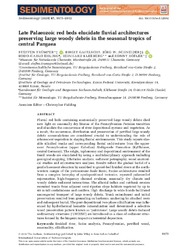Late Palaeozoic red beds elucidate fluvial architectures preserving large woody debris in the seasonal tropics of central Pangaea
Gaitzsch, Birgit
Ehling, Bodo-Carlo
Kleeberg, Reinhard
DOI: https://doi.org/10.1111/sed.12692
Persistent URL: http://resolver.sub.uni-goettingen.de/purl?gldocs-11858/9226
Persistent URL: http://resolver.sub.uni-goettingen.de/purl?gldocs-11858/9226
Trümper, Steffen; Gaitzsch, Birgit; Schneider, Jörg W.; Ehling, Bodo-Carlo; Kleeberg, Reinhard; Rößler, Ronny, 2020: Late Palaeozoic red beds elucidate fluvial architectures preserving large woody debris in the seasonal tropics of central Pangaea. In: Sedimentology, Band 67, 4: 1973 - 2012, DOI: 10.1111/sed.12692.
 |
Dokument öffnen: |
Fluvial red beds containing anatomically preserved large woody debris shed new light on seasonally dry biomes of the Pennsylvanian–Permian transition and elucidate the concurrence of river depositional systems and vegetation. As a result, the occurrence, distribution and preservation of petrified large woody debris accumulations are considered crucial to understanding the role of arborescent vegetation in shaping fluvial environments. This study reports sizeable silicified trunks and corresponding fluvial architectures from the uppermost Pennsylvanian (upper Gzhelian) Siebigerode Formation (Kyffhäuser, central Germany). The origin, taphonomy and depositional environment of the fossil woods are elucidated by using a multidisciplinary approach including geological mapping, lithofacies analysis, sediment petrography, wood anatomical studies and microstructure analyses. Results reflect the gradual burial of a gentle basement elevation by sand-bed to gravel-bed braided rivers at the north-western margin of the perimontane Saale Basin. Facies architectures resulted from a complex interplay of syndepositional tectonics, repeated palaeorelief rejuvenation, high-frequency channel avulsion, seasonally dry climate and woody debris–sediment interactions. The alluvial influx and cut-bank erosion recruited trunks from adjacent semi-riparian slope habitats vegetated by up to 40 m tall cordaitaleans and conifers. High discharge in wide braids facilitated uncongested transport of large woody debris. Trunk entombment and initial preservation resulted from grounding on barforms, anchoring by attached roots and subsequent burial. The post-depositional two-phase silicification was influenced by hydrothermal hematite mineralization and determined a selective wood preservation pattern known as ‘pointstone’. Large woody debris-induced sedimentary structures (‘LWDISS’) are introduced as a class of sediment structures formed by the biogenic impact on terrestrial deposition.
Statistik:
ZugriffsstatistikSammlung:
- Geologie [933]
This is an open access article under the terms of the Creative Commons Attribution-NonCommercial License, which permits use, distribution and reproduction in any medium, provided the original work is properly cited and is not used for commercial purposes.

